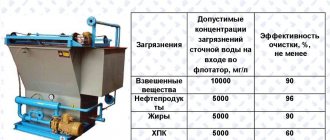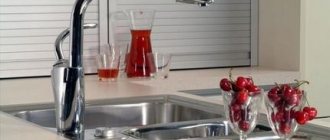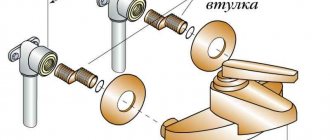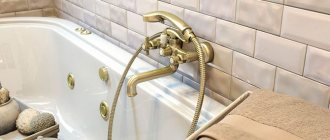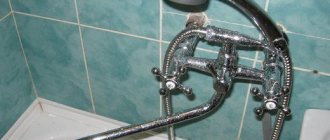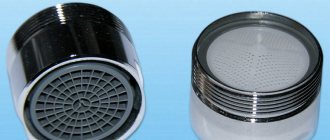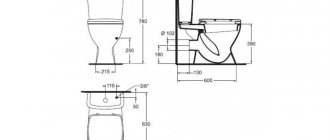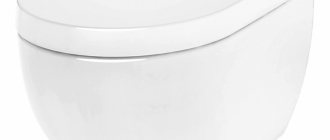- Types of sensors in touch mixers
- Types of eating methods
- Additional functions
- Touch faucets by installation method
- Advantages and disadvantages of automatic faucets
- The most popular manufacturers of sensor faucets
A sensor faucet is a device for mixing and dispensing water with an infrared sensor.
In simple words, this is a mixer in which, instead of levers and control valves, a special sensor is installed that reacts to movement and supplies the hearth. If the sensor does not detect movements for some time, it automatically turns off. Only one small lever can be installed on the mixer body, which regulates the water temperature, but not all models have it.
The standard equipment of the touch mixer includes:
- the mixer itself with a built-in water supply and mixing module;
- water supply kit;
- set of fastenings;
- The kit must also include a photocell power supply (this can be a battery or a power supply from an outlet).
Below we will look in detail at the differences between automatic faucets, analyze their advantages and disadvantages, and also provide the 5 most popular manufacturers of these products.
How touch faucets work
In appearance, the sensor faucet can be distinguished from its other counterparts by the absence of unnecessary parts. The design consists of one spout, without valves, levers, handles or other devices for regulating the water supply. The main difference between this device is the photocell and infrared sensor mounted in the body.
The sensor’s task is to detect movement in the signal recognition zone within 30 cm. The sensitivity zone is adjusted automatically or manually.
Manual adjustment independently determines the degree of required proximity to the tap. An additional option determines the time interval after which water is supplied from the tap and when it stops flowing (up to several seconds from the moment the start/stop of movement is detected).
Not only the feeding time and the sensitivity zone can be adjusted. Additionally, using the side lever, the required temperature or mode of mixing the proportions of hot and cold water is adjusted. There is no need to adjust the temperature every time you open the tap; the stream is supplied in a constant, strictly specified mode.
The touch sensor has another advantage. It only reacts to movement. If soap, a towel or other object falls in the sensitivity zone, water begins to flow and continues to flow until the sensor detects the presence of movement. As soon as the fallen object stops making any movements, the flow of the jet stops.
Availability of water mixing mechanism
Also pay attention to the presence of a water mixing function, because not all models have it.
With water mixing function
These sensor faucets have a small faucet with which you can regulate the water temperature.
No water mixing
Such models are a faucet with touch control. The water temperature in such faucets can be adjusted only for one mode using the built-in mixing function, by installing a separate faucet regulator, or not adjusted at all.
Device of touch mixers
Like any technological item, this model requires power supply via batteries. The battery charge lasts up to 2 years of active use in public places (up to 5 thousand automatic starts per month). At home, the battery charge will last much longer, so you don’t have to worry about replacing batteries.
The faucet kit with touch sensor includes:
- the electronic unit;
- batteries;
- spout;
- valve;
- temperature adjustment levers;
- connecting hose;
- filter.
Many of the models are equipped with a remote control to make settings for the device remotely.
The design of the model includes the presence of an induction sensor that creates a magnetic field. The entry of a foreign object into it serves as a signal to the control unit responsible for supply/shutdown.
The supply is provided by a special solenoid valve. This valve contains the following components:
- solenoid coil;
- shielding coil;
- core tube;
- membrane;
- saddle;
- compaction;
- housing with lid;
- spring;
- core;
- retainer;
- tip.
The water is opened by lifting the core with the membrane. Electrical voltage is supplied to the zone of the electromagnetic field that affects the core. The check valve protects against backflow.
Kinds
- Depending on the purpose of the devices, they are divided into kitchen models (with a swivel or U-shaped spout), models for urinals (built-in, external), and models for toilets (automatically adjusted to flush).
- By appearance (models with push-button sensors, display, non-contact, with built-in lamp).
- According to the length of the supplied jet (more than 35 cm long, medium, short, with a rotating mechanism, fixed).
- According to the principle of operation (spout from separate taps, single lever, electronic, double spout).
Pros and cons of touch faucets
Advantages of touch mixers This model has many positive characteristics - from convenient use to wide areas of application, reliability and manufacturability.
- Practicality. The sensor faucet is indispensable when arranging public places. Nightclubs, cafes and restaurants, health and entertainment centers, educational and medical institutions are equipped with such models. The increased interest in these devices is quite justified. With repeated active use, valves and levers failed, required replacement of parts, and led to idle plumbing fixtures. When switching to touch sensors, the need to repeatedly rotate valves, adjust the required temperature conditions has disappeared, and unreasonable waste of water during a leak of a faulty faucet is eliminated. Conventional devices are inferior to touch devices in terms of wear resistance and safety.
- Hygiene. The need to rotate valves and levers to supply the jet forces people to touch them with their hands. Dirty hands leave germs and bacteria on the surface of valves and levers. Subsequent users of water are forced to touch contaminated valves and transfer infections and pathogens further. Constant treatment with disinfectants will not give results - after all, you will have to constantly wipe with a disinfectant solution. In models with a touch water supply sensor, you do not need to touch the faucet surfaces. This means that the risk of infection or transfer of foreign microbes is minimal. This feature was appreciated and began to be used in places where disinfection is especially important - children's institutions.
- Rational use of water. Touch models are also supported by the fact that there is no need to monitor how tightly the tap is closed, whether the threads are broken, or whether there are leaks. Saving water consumption will significantly reduce the costs of public catering establishments. Cafe visitors may forget to turn off the tap or not bother doing so at all. It is impossible to control the degree to which the tap is closed for each visitor to the restroom. And it’s not necessary - the sensor will do it.
- Safety at home. When leaving for the whole day, the apartment owner does not worry whether the tap is closed or whether there is a risk of flooding the neighbors due to a faulty faucet.
- Convenient operation. Setting the water temperature is done once. There is no need to additionally adjust the hot and cold water supply pressure to set the desired temperature. The device will automatically adjust the temperature on its own.
- Aesthetic appearance. The design of this design is elegant and lightweight, which allows it to be used in various interior designs.
Disadvantages of touch faucets Despite its external beauty and practicality, this model is not suitable for arranging kitchen sinks. Installation of a sensor model involves supplying water at a relatively constant temperature.
In the kitchen, it is often necessary to change the degree of heating - for washing dishes, the water should be warm or hot, for washing fruits and vegetables - colder, sometimes you need to quickly cool a particular product, or vice versa, warm it up.
Housewives also need to regulate the power supply. The optimal choice in the kitchen is a conventional single-lever device - the water is easily opened and adjusted with one movement of the hand.
Sometimes you need to use a sink to fill it with water. Under normal conditions, for these purposes, the sink is plugged with a stopper and water is supplied. In order for the sensor to allow water to collect, you will have to constantly move your hands so that the water continues to flow to the required level. Quite an inconvenient way to fill the sink.
For the same reason, the touch sensor will not allow you to fill the bathtub or pour water into the basin. You will need to turn off the sensor once, apply pressure, and turn it on again after filling. There is no need for such labor-intensive use of the sensor. It is easier to install a model with a conventional spout (single-lever or valve mixer).
Thus, the functionality of the sensor device limits the scope of application - either for installation on washbasins, in the toilet at home, or as washbasins in public areas.
What's happened?
Sensor faucets are faucets that automatically dispense water when you place your hands near the spout. And they stop feeding when you remove your hands from under the spout. That is, there is no need to turn the water on and off, adjust the desired temperature and flow intensity - the “smart” mixer will do everything for you.
In everyday life you can hear other names for this device: automatic faucet, touchless faucet, infrared faucet. Such taps are called “automatic faucets” because the supply and stop of water supply occurs automatically. This name is quite logical. The name “touchless faucet” implies that there is no direct contact between a person and the device during use. So this name also fully corresponds to reality. The name “infrared mixer” suggests that the device has an infrared sensor installed. But in fact, touchless faucets can be equipped with sensors of different operating principles, not only infrared. Therefore, this name is rather clarifying and characterizes only a specific category of automatic mixers. And finally, the “sensory mixer”. Since “sensor” means “sensor” in general, this is the name most often heard.
Installation
Installation of the sensor mixer is done in two stages. 1st stage. The body part is installed. 2nd stage. The device is connected to the water supply. The water supply must be shut off before installation.
The housing is installed in a place prepared for this purpose - a hole in the sink. If an old mixer was used before, it must first be dismantled. A round mounting gasket must be placed between the sink and the tap. The lower part of the device is attached to a gasket or plate, then secured with a nut.
All necessary mounting materials are included with the device.
The control box is secured using 4 additional bolts. It is placed at a distance of at least 50 cm (on average about 55 cm) from the floor. The mixer is connected to the control box with a flexible hose with the obligatory placement of a gasket.
The device is connected to the water supply system using nipples. The hot water tube is connected to the nipple marked in red, the cold water tube is connected to the nipple marked in blue.
Correct operation of the solenoid valve is ensured by a sensor wire connected via a connecting nut to the control box. To install the batteries, unscrew 4 bolts and remove the cover. After placing the batteries, the cover is fixed back.
After installation work is completed, the water supply is connected and the operation of the tap is checked. To do this, you need to bring your hands into the sensitivity zone of the photocell and check whether water flows. Next, the work is adjusted - the time interval before/after the end of water supply, temperature conditions, sensor sensitivity areas.
Problems
If the sensor breaks down, it is not recommended to repair it yourself. In this case, it is better to contact a professional.
More often, users of a sensor faucet encounter clogging of the aerator. A sign of clogging is a reduced jet pressure.
To fix the problem, you need to remove the rusty aerator and replace it with a new one.
Flaws
- It can be considered an inconvenience in the bathroom when you need to draw a lot of water. You will have to keep your hands under the tap the entire time. Means loss of time and relative inconvenience. And while washing in the bath, you will generally need to turn off the sensor;
- There are two sides of the coin in the kitchen. On the one hand it is very convenient. After all, when working with products, your hands are often dirty and, when opening a mixer with handles, you then have to wash them. But on the other hand, you need warm water for washing dishes, and cold water for cooking. It will be inconvenient to switch the temperature all the time.
When choosing a sensor faucet, it is best to consult with a professional salesperson in the store. He will tell you all the nuances, select the right color and design.
We recommend articles on the topic:
How to replace the gasket in a faucet with your own hands?
How to choose
The first thing people pay attention to is whether the mixer is really touch sensitive. On the plumbing equipment market, there are similar models of conventional taps with a sensor for stopping and starting the water supply.
Unlike a faucet, the water in a regular tap is not mixed - it flows either hot or cold and is only suitable for a single-pipe water supply system. In addition, there are two mounting holes for two taps in the sink.
The second point that is taken into account when purchasing is for what purposes the mixer is intended to be used. You should not buy it for installation on the kitchen sink or for the bathtub. All the strengths and advantages of the faucet lie in its operation on washbasins (washing hands, washing, etc.) with frequent use in one constant temperature mode, with the same water supply pressure.
Such a faucet is a godsend for restrooms in public places - cafes and restaurants, gyms, various children's centers, entertainment, educational or medical institutions.
This application option will really reduce water consumption, the cost of repairing plumbing equipment, eliminate the risk of leaks, and reduce the chances of infection through touching common valves.
Since this device belongs to technological equipment that works on the principle of a “smart home” system, the budget for its purchase is higher than for a regular mixer. This is taken into account when choosing a particular model.
When selecting a sensor device, attention is also paid to the design of the room, the ability to combine style with other interior elements - color, shape, material.
Thanks to the wide range of models, choosing the best option will not be difficult. Advertising from sponsors: // // //
Tips for choosing
Those who decide to purchase a sensor mixer should first of all study the documentation supplied with it. What should you pay special attention to?
Spout shape
Is this model compatible with a previously installed sink?
Sensitivity zone limits
Basically, it is from 1 to 30 cm. It is necessary to correlate this characteristic with the depth of the sink bowl, so that it does not happen that as soon as, for example, a dirty plate is lowered into it, the water supply is automatically turned on. Therefore, it is more advisable to buy a touch-type mixer with the ability to independently adjust the sensitivity.
Temperature adjustment
To what extent, how convenient? For domestic use of a mixer, these are important issues.
Manufacturer
An important factor considering how intensively the mixer is used. We use this device every day, many times. Therefore, if you are going to spend money, you must be sure that the plumbing fixtures are really high quality and will last long enough.
Based on user reviews on social networks, we can conclude that among domestic faucets, products under the Aquaton and Santekhpribor brands stand out for the better. German models “Hansgrohe” and “Grohe”, Finnish “Oras”, “Jacob Delafon” from France and “Damixa” from Denmark have proven themselves well. High-quality assembly and reliability in use of these mixers are time-tested.
But there are different opinions about various “bells and whistles”. Some consider additional options (remote reconfiguration of the mixer and control) a plus, but for others it is nothing more than an excess that significantly increases the cost of plumbing.
By the way, about the price. It varies widely, since the range of mixers is quite impressive. You can purchase a standard model for 5,450 rubles, but there are “exclusive” devices for 59,000.
Here, perhaps, are all the main points. Manufacturers are constantly refining and improving something, so keeping track of various “innovations” is unrealistic. There is a passport of the device, which contains all the information, and the author explained the nuances of the device and choice. It is up to you, dear reader, to make the final decision on the advisability of purchasing such a mixer. Good luck!
